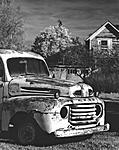Wow, infrared when it is done right!
I've never had a problem with Efke IR820 in a Grafmatic holder letting light through the thumb indent. After the Grafmatic is inserted into the camera back the slide is pulled thus allowing the next septum and its sheet of film to jump forward. Then the slide is pushed back in to form a light-proof barrier behind the septum + film and the exposure is made. Finally the chrome trigger is depressed so it engages with the finger loop and the Grafmatic magazine section is pulled out to allow the exposed sheet to go to the back of the stack, The magazine section is pushed back in and the Grafmatic is ready for another exposure sequence with the number wheel advanced by one.
Grafmatics are wonderful and occasionally treacherous until tweaked to perfection. I've done all the mistakes including fogging a complete stack of films (thankfully not Efke) through the thumb indent!
Photography:first utterance. Sir John Herschel, 14 March 1839 at the Royal Society. "...Photography or the application of the Chemical rays of light to the purpose of pictorial representation,..".
Thanks
I've just had a revelation, I think using the Grafmatic is fine, before you posted I was thinking about it and trying to figure out how it could have happened, the dark slide goes behind the front septum so that shouldn't happen, I realized that the first 2 images shot were in my Toyo45a, the two shots were completely fogged.
So I think what happened is that because the bellows were not infrared light tight, when I changed and rotated the septum, light got through the thumbhole area and fogged all six sheets at once. In addition the two sheets I shot were completely fogged (which is a shame, they were images shot in Canada).
I had always had a little light fogging on the Rollie IR400 film, but I was told it aged fast (like 3200 speed films) so I attributed it to that, and since it's less IR sensitive it wasn't obvious. It was fully normal light proof.
So now I'm going back to using the Grafmatic once I shoot through the 4 DDS holders I loaded.
Back out to visit the town truck. It's moved few feet since last shot and the distant tree is in bloom now. I shot with a 360 mm lens, Rollei infrared 4x5 and Cokin X007 filter, f32, 1s, developed in HC100 B. Too bad the other trees were only starting to bud. Another try might be good in a couple more weeks.

ex-Pic-A-Day (slowed after 2 years)
on flickr
Analogue Photo and Film FAQ (for APUG)
Open Source F/Stop Timer
Great pictures! I love infrared. Hope you don't mind a quick explanation of the imaging bands in use today (using the non-astronomical convention). I thought it might be of interest, even though it's sort of off-topic.
A snake's thermal sense works at infrared wavelengths much different than this, and would look very different.
IR film sees up to about 900 nm right? and so still operates in what is termed the reflective (VIS/NIR) spectra. VIS is 450-650nm, and NIR (near-infrared) is 650 to about 1000nm, or 1 um. The convention is widely used, and is tied to the response of traditional imaging material such as silver halides and silicon detectors. Detection is primarily by reflected light.
The Short-wave infrared, or SWIR band ranges from 1 um (1000 nm) to 1.7 um. Indium Gallium Arsenide is the primary detector material used here. It still operates primarily by reflected energy. I haven't seen any artistic use of SWIR cameras yet, but you can google SWIR images and see what they look like. If you're looking for a digital imaging project and have the ~$50k to spare for the cost of a camera, then you could break new artistic ground. Most clothing dyes are transparent, as is polyester. Hair looks different. Foliage is bright in this band as well. Water is very dark. I think SWIR sees use in analyzing the layers of classical paintings, taking advantage of transparency of the pigments. So you can, for example, see the underlying pencil sketchings drawn out before the artist began painting.
Mid-wave infrared (MWIR) operates from 3-5um, and operates primarily via emissive energy. That is, contrast is determined by the temperature of the objects in the scene.
The Long Wave Infrared (LWIR), or thermal band, is defined as ~7-13 um. This is your traditional thermal band that is widely used today. Again, contrast in the scene is determined by temperature of the objects. Microbolometers are very popular today for use as a detector material. From color temperature theory, objects at room temperature are the "brightest" objects in this band. So people in the woods stand out very well. You can look up images for examples. This is where a snake's thermal sense works.
For them, a scene outdoors would look uniformly gray (everything at the same temperature), with the only real contrast occurring between the background and warmer objects such as mice, rodents, etc. Their heat sensing pad is very low resolution, and interestingly enough, they use very significant processing in their little brain to form a useable image.
Newly made large format dry plates available! Look:
https://www.pictoriographica.com
Bookmarks